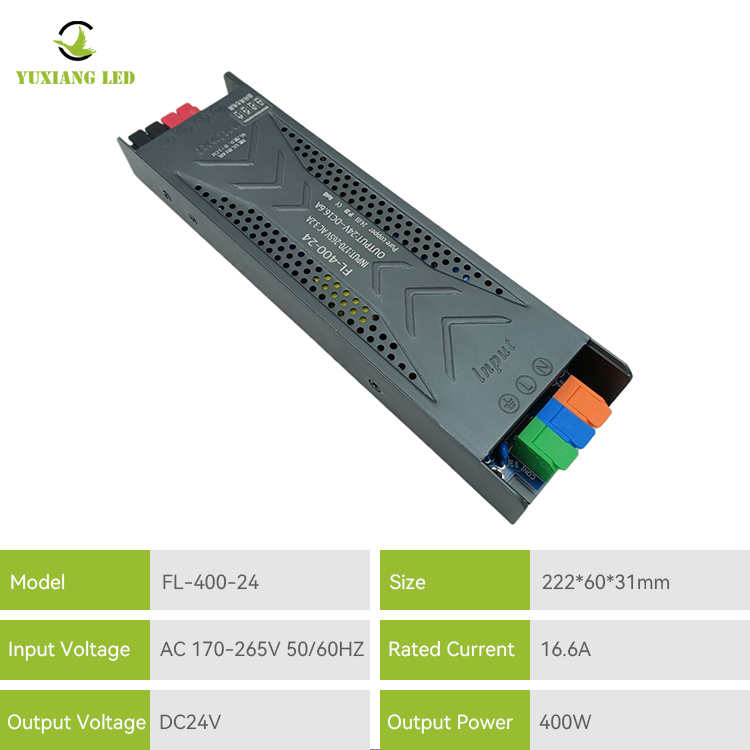Considerations for LED Linear Lighting Power Supplies
2024-06-04
An LED linear lighting power supply, also known as an LED driver or LED power supply, is a crucial component in LED lighting systems. It converts AC voltage from mains power into the appropriate DC voltage and current required to power LED light fixtures. Here's a detailed overview of LED linear lighting power supplies, including their features, types, applications, considerations, and benefits:
Key Features of LED Linear Lighting Power Supplies:
1. Voltage Conversion:
- Converts AC voltage from mains power (typically 120V or 240V) to the appropriate DC voltage required by the LEDs (usually 12V or 24V).
2. Constant Current or Constant Voltage Output:
- Provides either a constant current or constant voltage output, depending on the requirements of the LED lighting system.
3. Dimming Capabilities:
- Some LED drivers support dimming functionality, allowing for adjustable brightness levels and control over the lighting environment.
4. Efficiency:
- High-efficiency power conversion, minimizing energy losses and maximizing the energy efficiency of the LED lighting system.
5. Protection Features:
- Built-in protection mechanisms such as overvoltage protection, overcurrent protection, short-circuit protection, and thermal protection ensure safe and reliable operation of the LEDs.
6. Compact Size:
- Compact and lightweight design for easy installation and integration into LED lighting fixtures.
Types of LED Linear Lighting Power Supplies:
1. Constant Voltage LED Drivers:
- Provide a fixed output voltage (e.g., 12V or 24V) and varying output current to drive LED light fixtures requiring a constant voltage power source. Commonly used for LED strip lights, linear fixtures, and signage.
2. Constant Current LED Drivers:
- Provide a fixed output current and varying output voltage to drive LED light fixtures requiring a constant current power source. Commonly used for high-power LEDs and LED arrays.
3. Dimmable LED Drivers:
- Support dimming functionality, allowing for adjustable brightness levels and compatibility with dimmer switches or lighting control systems.
4. Non-Dimmable LED Drivers:
- Provide fixed output voltage or current without dimming capabilities. Suitable for applications where dimming is not required.
Applications of LED Linear Lighting Power Supplies:
1. Architectural Lighting:
- Illumination of building facades, bridges, and landmarks with linear LED fixtures and signage.
2. Commercial Lighting:
- Lighting for retail stores, offices, restaurants, and hotels using linear LED fixtures for general and accent lighting.
3. Industrial Lighting:
- Illumination of warehouses, factories, and manufacturing facilities with linear LED fixtures for high-bay and low-bay lighting applications.
4. Residential Lighting:
- Task lighting, under-cabinet lighting, and accent lighting in homes using LED strip lights and linear fixtures.
5. Outdoor Lighting:
- Landscape lighting, pathway lighting, and architectural accent lighting using weatherproof linear LED fixtures.
Considerations for LED Linear Lighting Power Supplies:
1. Voltage and Current Ratings:
- Select a power supply with output voltage and current ratings compatible with the requirements of the LED lighting system.
2. Dimming Compatibility:
- Ensure compatibility with dimming controls and lighting systems if dimming functionality is desired.
3. Protection Features:
- Choose a power supply with built-in protection features to ensure the safety and longevity of the LED lighting system.
4. Efficiency and Power Factor:
- Look for high-efficiency power supplies with a high power factor to maximize energy efficiency and minimize power losses.
5. Temperature Rating:
- Consider the operating temperature range of the LED driver to ensure reliable performance in the intended environment.
Benefits of LED Linear Lighting Power Supplies:
1. Energy Efficiency:
- High-efficiency power conversion and low standby power consumption contribute to energy savings and reduced operating costs.
2. Longevity:
- Reliable operation and built-in protection features prolong the lifespan of LED light fixtures and reduce maintenance requirements.
3. Flexibility:
- Compatibility with dimming controls and lighting systems provides flexibility in adjusting brightness levels and creating dynamic lighting effects.
4. Compatibility:
- Designed to work seamlessly with LED light fixtures, ensuring optimal performance and compatibility with various lighting applications.
5. Environmental Friendliness:
- Energy-efficient operation and long lifespan contribute to a reduced carbon footprint and lower environmental impact compared to traditional lighting systems.
Conclusion:
LED linear lighting power supplies play a critical role in driving LED light fixtures by converting AC voltage from mains power into the appropriate DC voltage and current required by the LEDs. With features such as voltage conversion, dimming capabilities, efficiency, and protection mechanisms, they provide reliable and efficient power solutions for a wide range of lighting applications. By considering factors such as voltage/current ratings, dimming compatibility, and protection features, users can select the right LED power supply to meet the requirements of their lighting systems and achieve optimal performance and longevity.



